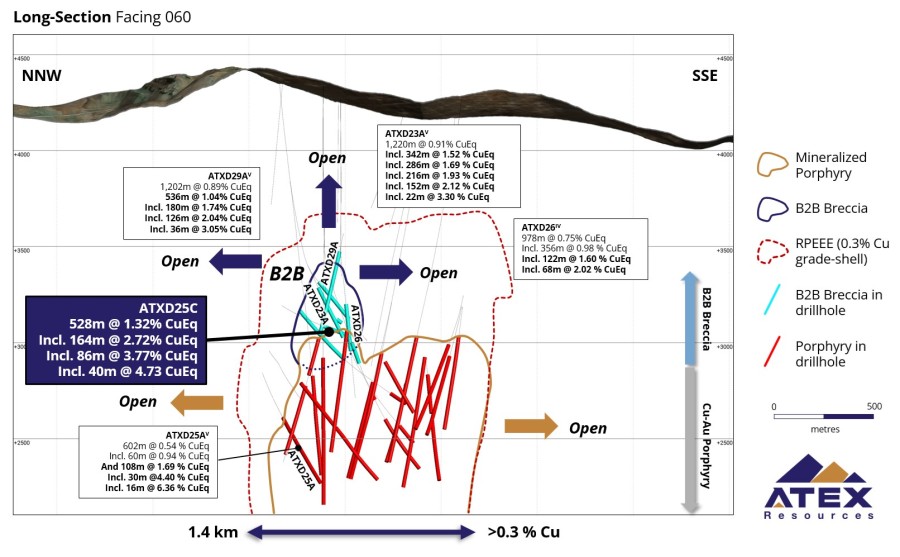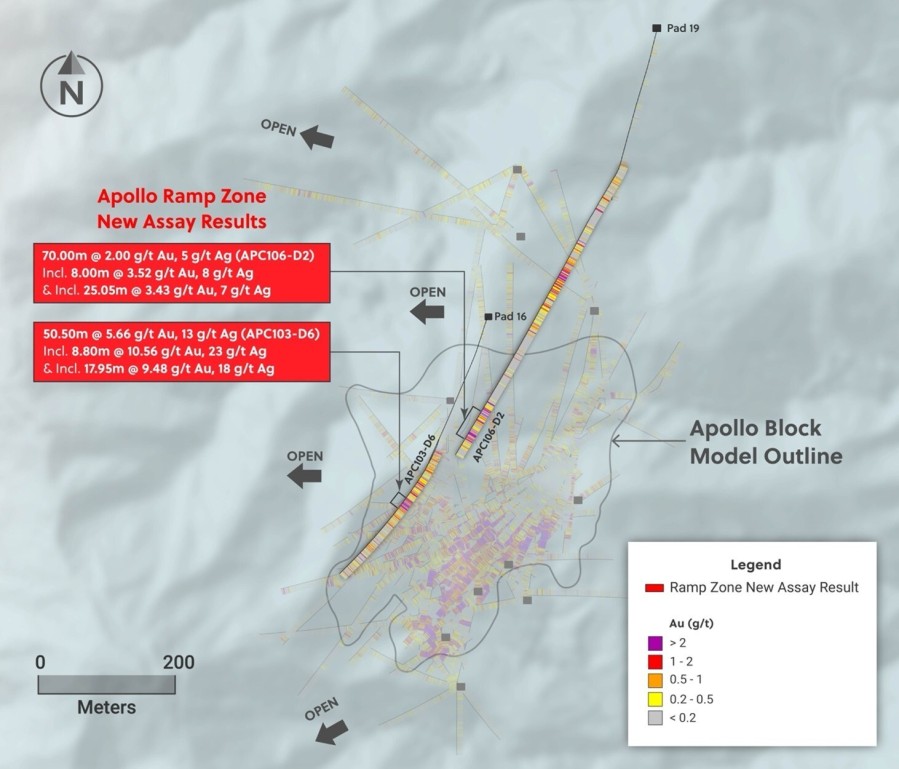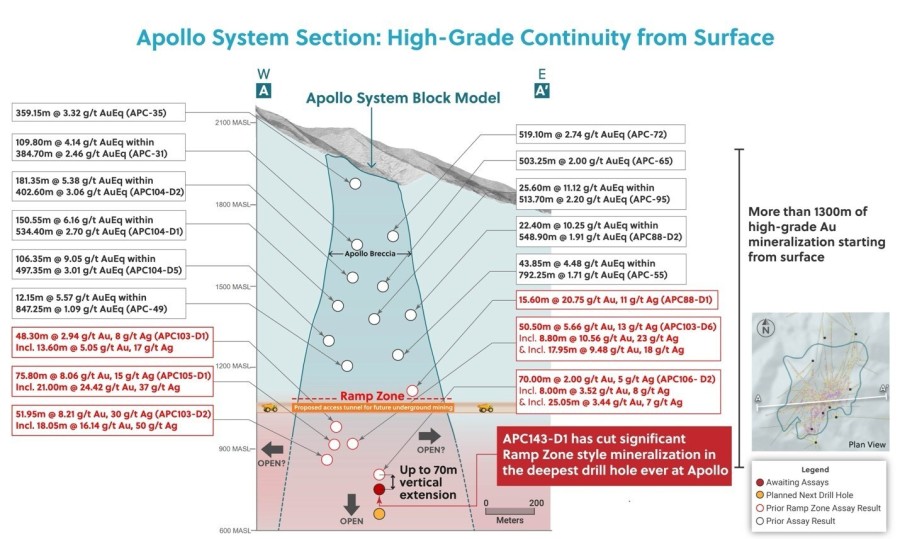Winnipeg, Manitoba--(Newsfile Corp. - July 18, 2025) - Snow Lake Resources Ltd., d/b/a Snow Lake Energy (NASDAQ: LITM) ("Snow Lake"), a uranium exploration and development company, provides an update on progress at its uranium projects in Wyoming and Namibia, together with how the exploration and development of such projects hold the potential to directly support U.S. national and energy security objectives.
Highlights
-
Drill rigs set to start turning the week of July 21, 2025 at the flagship Pine Ridge uranium project ("Pine Ridge") in Wyoming
-
Pine Ridge is a 50/50 joint venture (the "Joint Venture") between Snow Lake and Global Uranium and Enrichment Limited ("GUE")
-
The drill campaign at Pine Ridge is planned to undertake a total of ~38,000m (125,000ft) of drilling
-
Pine Ridge is a near development In-Situ Recovery ("ISR") uranium project located in the heart of Wyoming's prolific Powder River Basin primed for rapid advancement
-
The objective of the current drill program at Pine Ridge is to produce a maiden resource estimate prior to the end of 2025
-
The Engo Valley uranium project ("Engo Valley") Phase 2 drill program continues, and is planned to consist of up to approximately 7,500 meters of a combination of reverse circulation and diamond drilling
-
Phase 2 is designed to provide a drill database sufficient to calculate a maiden uranium resource estimate in accordance with SK-1300 prior to the end of 2025
-
U.S. Administration executive orders on nuclear energy and domestic production of critical minerals, including uranium, provide significant tailwinds to support the development of our Pine Ridge and Engo Valley projects
CEO Remarks
"The U.S. needs more uranium mines in order to achieve its policy objectives of national and energy security. We are of the firm belief that our Pine Ridge uranium project in Wyoming holds the potential to become one of those new uranium mines," said Frank Wheatley, CEO of Snow Lake.
"With the commencement of drilling at Pine Ridge, our drilling programs on our Pine Ridge uranium project in Wyoming, and our Engo Valley uranium project in Namibia, are now in full swing, and our objective for both projects is to produce a maiden resource estimate prior to year end."
Mr. Wheatley continued: "With unprecedented demand for electricity, coupled with the U.S. Administrations strong support for nuclear energy to ensure U.S. national and energy security, we are excited to begin our drill program at Pine Ridge, which we feel has all the characteristics of a leading U.S based uranium development project that holds the potential to positively contribute to satisfying the U.S. goals of energy security."
U.S. Administration Support of Uranium Mining
The U.S. Administration has issued a number of executive orders that directly support the development of nuclear energy, and the domestic production of critical minerals, including uranium.
In May, 2025, the U.S. Administration issued four executive orders (the "Nuclear Executive Orders"), designed specifically to accelerate the deployment of nuclear energy in the U.S. as the AI arms race between the U.S. and China heats up, and which will help fast-track Snow Lake's Pine Ridge uranium project development timelines.
The Nuclear Executive Orders are designed to
-
Accelerate the deployment of nuclear energy in the U.S.
-
Deploy advanced nuclear reactor technologies, including SMRs
-
Quadruple nuclear energy in the U.S. by 2050
-
Reinvigorate the nuclear industrial base, including uranium mining and enrichment
- Combined with all previous Executive Orders on critical minerals, these orders will:
-
Dramatically increase global demand for uranium
-
Accelerate U.S. domestic uranium mining
- The AI arms race between the U.S. and China continues to heat up, and is driving massive:
-
Investments in data centres to drive the AI revolution
-
Demand for nuclear energy to power data centres
-
Demand for uranium, including new uranium mines, to power nuclear reactors
- Acceleration of Pine Ridge Development Timelines
- The Executive Orders have the potential to fast-track Pine Ridge through development, permitting, and into production
Drill Program at Pine Ridge
The Joint Venture has selected Single Drilling to execute its initial drilling program at Pine Ridge. Single Drilling brings extensive operational experience, having successfully completed numerous previous drilling campaigns at the Pine Ridge site. Their familiarity with Pine Ridge is expected to support an efficient and well-executed program, with the potential addition of a second rig to accelerate progress. In addition, the Joint Venture has engaged Hawkins CBM Logging, Inc. as the geophysical contractor to provide specialized support for the drill program.
Pine Ridge is an advanced ISR opportunity of significant scale within the Powder River Basin of Wyoming, the premier US uranium basin. It is also located in one of the most mining friendly states. Pine Ridge has been significantly de-risked through historical drilling and has an ideal geological foundation to be developed into a production asset.
The 2025 exploration program will focus on testing high-priority target areas, with approximately 38,000 m (125,000 ft) of drilling to be completed to rapidly advance the project. The determination of targets has been guided by extensive data compilation from prior historical drilling and geological review. The expected start date for drilling is July 21, 2025.
Drill Program at Engo Valley
The Phase 2 drill program ("Phase 2") at Engo Valley has been designed to follow up on the Phase 1 drill program completed in 2024, and will focus on the MUO and D1 target areas The objective of Phase 2 is to develop a drill data base sufficient to calculate a maiden mineral resource estimate for Engo Valley by the end of 2025.
To date, a total of 21 infill RC holes have been completed in the MUO, 6 infill RC holes within the D1 North area, and 4 RC holes were completed in the MUO-D1 area.
The diamond drilling segment of Phase 2 started in June, 2025. A total of 19 diamond drill holes are planned for the MUO and 8 diamond drill holes are planned to be drilled in the D1 area.
Downhole radiometrics will be completed on each drill hole with a gamma spectrometer probe.
About Snow Lake Resources Ltd.
Snow Lake Resources Ltd., d/b/a Snow Lake Energy, is a Canadian mineral exploration company listed on Nasdaq:LITM, with a global portfolio of critical mineral and clean energy projects. The Pine Ridge Uranium project is an exploration stage project located in Wyoming, United States, and the Engo Valley Uranium Project is an exploration stage project located in the Skeleton Coast of Namibia. Snow Lake also holds a portfolio of additional exploration stage critical minerals projects located in Manitoba, as well as investments in a number of public companies with critical minerals assets. Learn more at www.snowlakeenergy.com.
Forward-Looking Statements: This press release contains "forward-looking statements" within the meaning of Section 27A of the Securities Act of 1933, Section 21E of the Securities Exchange Act of 1934 and the "safe harbor" provisions under the Private Securities Litigation Reform Act of 1995 that are subject to substantial risks and uncertainties. All statements, other than statements of historical fact, contained in this press release are forward-looking statements, including without limitation statements with regard to Snow Lake Resources Ltd. We base these forward-looking statements on our expectations and projections about future events, which we derive from the information currently available to us. Forward-looking statements contained in this press release may be identified by the use of words such as "anticipate," "believe," "contemplate," "could," "estimate," "expect," "intend," "seek," "may," "might," "plan," "potential," "predict," "project," "target," "aim," "should," "will," "would," or the negative of these words or other similar expressions, although not all forward-looking statements contain these words. Forward-looking statements are based on Snow Lake Resources Ltd.'s current expectations and are subject to inherent uncertainties, risks and assumptions that are difficult to predict. Further, certain forward-looking statements are based on assumptions as to future events that may not prove to be accurate. Some of these risks and uncertainties are described more fully in the section titled "Risk Factors" in our registration statements and annual reports filed with the Securities and Exchange Commission. Forward-looking statements contained in this announcement are made as of this date, and Snow Lake Resources Ltd. undertakes no duty to update such information except as required under applicable law.
| Contact and Information Frank Wheatley, CEO |
Investor Relations Investors: This email address is being protected from spambots. You need JavaScript enabled to view it. Website: www.snowlakeenergy.com |
Follow us on Social Media Twitter: www.twitter.com/SnowLakeEnergy LinkedIn: www.linkedin.com/company/snow-lake-energy |
Pine Ridge Uranium Project
Overview
Pine Ridge is an advanced ISR uranium project located in the southwestern Powder River Basin of Wyoming, the premier U.S. uranium basin.
Figure 1: Pine Ridge Uranium Project and Adjacent Properties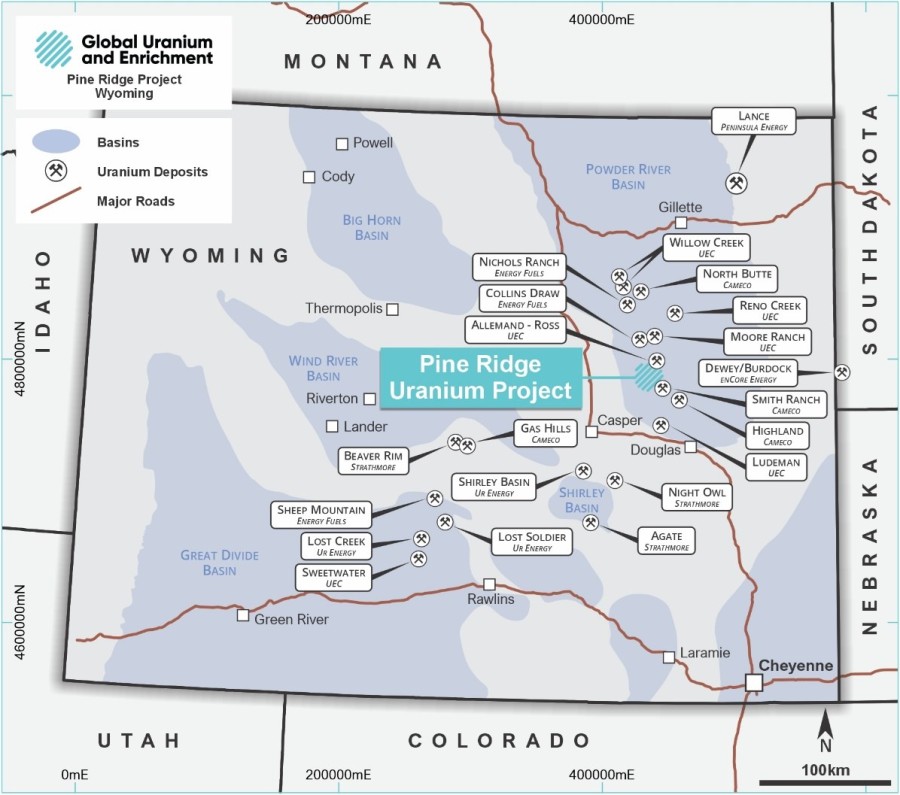
Pine Ridge is surrounded by existing uranium projects held by UEC and Cameco and is also located only ~15km from Cameco's Smith Ranch Mill which has licensed capacity of 5.5Mlbs U3O8 p.a. The Smith Ranch mill is one of the largest uranium production facilities in the U.S.
Pine Ridge is a uranium project of potential significant scale with a large JORC 2012 exploration target. For more information on this exploration target, please refer to GUE's website1.
2025 Exploration Program
The Joint Venture has consolidated the existing historical data on the project area and integrated it with available public information from nearby projects to develop a 3D model of the known mineralization and potential mineralization. The results of this data compilation and evaluation led to the staking of an additional 937 claims at Pine Ridge and increasing the Joint Venture's landholding to a total of approximately 15,130 ha (37,387 acres).
In addition, the understanding and results from the data compilation and geological review has guided the development of high-priority drill targets in the area (shown in red below), with approximately 38,000 m (125,000 ft) of drilling to be completed inside these areas during the initial exploration program.
Figure 2: Priority Areas for 2025 Exploration Program at Pine Ridge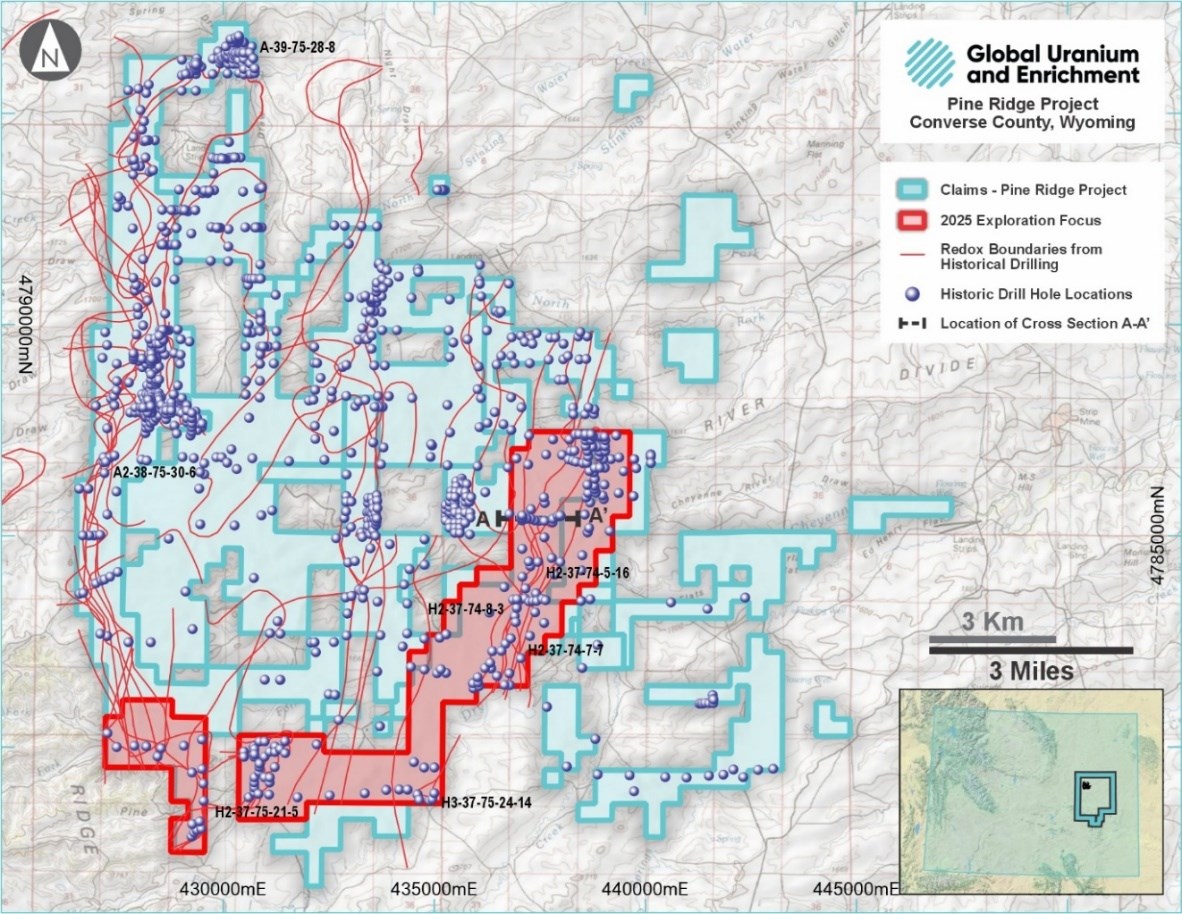
Conoco drilled 765 holes into the project area and the prior owners of Pine Ridge drilled an additional 449 holes. Their drill campaigns were primarily designed to continue building on the geologic understanding of the project while testing key areas for uranium potential. The results from these drill campaigns allowed the prior owners to develop a model that included 335 km of redox boundaries hosted in stacked horizons within the Tertiary sandstones. This interpretation is further supported by adjacent ISR properties with published resources.
Engo Valley Uranium Project
Overview
The Engo Valley Uranium Project is located in the Skeleton Coast, in the Opuwo District of the Kunene Region, along the coast of northwest Namibia, approximately 600 kilometers north of Swakopmund, Namibia (see Figures 1 and 2). Uranium mineralization was discovered in 1973 and exploration was conducted intermittently by Gencor between 1974 and 1980. The Engo Valley Uranium Project is considered to be a top tier exploration project.
The project is accessible from the south via 190km of desert track roads from Mowe Bay, via the Sarusas mine. To the east there are unconfirmed track roads that connect the project area to the settlement of Orupembe.
Exclusive Prospecting License
Prospecting License EPL 5887 (the "License") is registered in the name of the Project Company and covers a surface area of approximately 68,283 hectares (see Figure 2). The License was granted for industrial minerals, non-nuclear fuel minerals, nuclear fuel minerals, precious metals and precious stones, which includes uranium.
A valid environmental clearance certificate has been issued by the Namibian Ministry of the Environment to the Project Company, allowing exploration work to be undertaken on the License.
Current Uranium Operations in Namibia
Namibia hosts many proven uranium deposits, including 3 major deposits, 2 of which are currently in production:
Rossing Mine: One of the largest open pit uranium mines in the world, operating since 1976, currently producing 3,711 tonnes of uranium oxide per annum; 8% of the global output. By the end of 2021, Rossing had supplied 142,908 tonnes of uranium oxide.
Husab Mine: Swakop Uranium started development of the mine in 2013 and production started at the end of 2016. The main part of the Husab mine is the Rossing South orebody, about 5 kilometers south of the Rossing mine and 45 kilometers north east of Walvis Bay, producing about 5,500 tonnes of uranium oxide per annum.
Langer-Heinrich Mine: One of the largest uranium reserves in Namibia having estimated reserves of 57,000 tonnes of ore grading 0.055% uranium, with the past producing mine currently in process of resuming operations.
Figure 1: The Engo Valley Uranium Project (EPL 5887)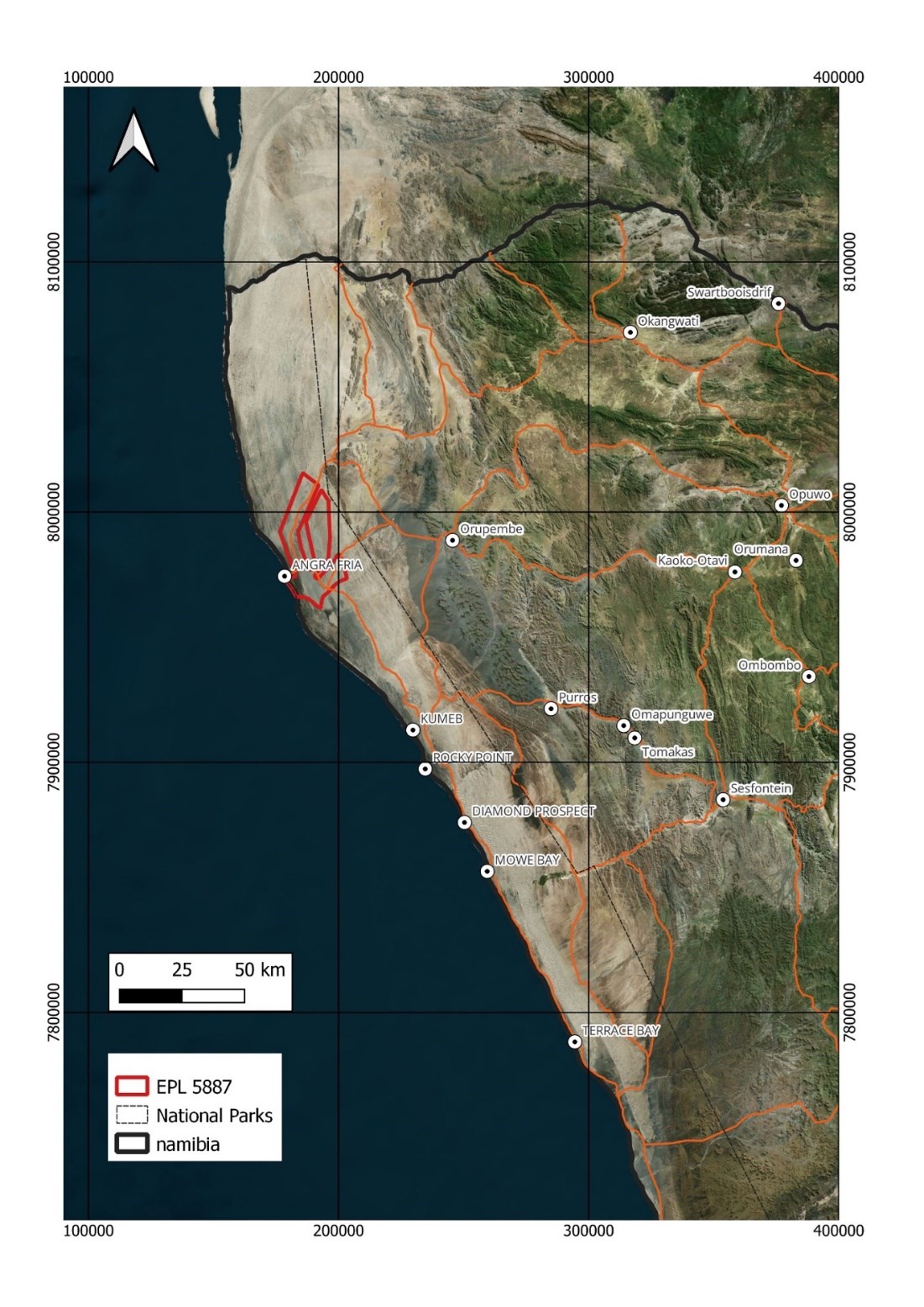
Figure 2: The Engo Valley Uranium Project, indicating "Angra Fria" or Cape Fria, the site of a proposed 3rd Namibian Atlantic port. 2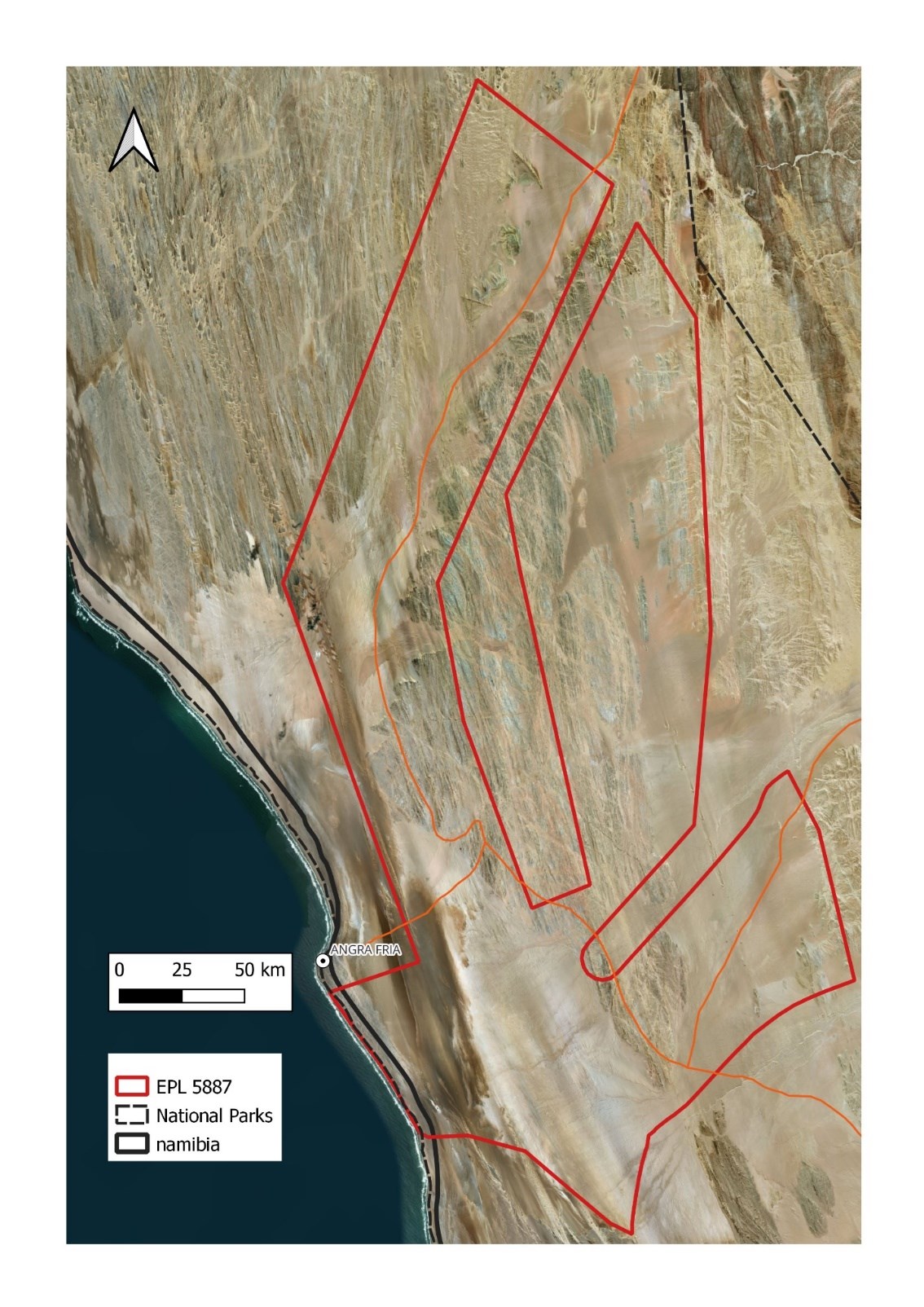
Geological Setting - Engo Valley Uranium Project
In the Engo Valley Uranium Project, uranium mineralization occurs in the sedimentary strata of the Karoo Sequence: as an unconformity-related in a fluvio-glacial alluvial fan type deposit in the of the Dwyka Formation and has potential for a roll-front type deposit in the Engo Formation. Uranium mineralization occurs as disseminated carnotite in the clastic sediments of the Dwyka Formation and as fine-grained uraninite in the black shale and the pink sandstone of the Engo Formation. The pink sandstone has not been adequately investigated.
The Munutum and Natas Valley area east of the Engo Valley area also has not been adequately explored. Historical airborne radiometric data indicates the potential for a shallow calcrete-hosted uranium mineralization.
Historical Exploration
Gencor conducted an exploration / reconnaissance program intermittently between 1974 and 1980. The program was comprised of airborne radiometric survey, ground radiometric survey, geological mapping, diamond and percussion drilling, limited resistivity work and limited radon etch survey. A total of 5,784 meters of drilling were completed, including 1,061 meters of diamond drilling.
The airborne radiometric survey was confined to the western side of the License along the Engo Valley paleochannel. The survey delineated four anomalies, named D1, D2, D3 and D4. D1 was further delineated into three anomalies named D1 Extension, Main Uranium Occurrence (MUO), and Louw's Valley.
Most of the historical exploration was focused in D1 and most of the drilling was concentrated in the MUO. The drilling was widespread, non-systematic and non-grid pattern. An untested anomaly, named D5, has not been evaluated for uranium and covers an area of 14 square kilometers with a strike length of 7 kilometers.
A historic, non-compliant S-K 1300 mineral resource estimate was completed by Gencor in the 1970's on the MUO and D1 Extension.
Phase 1 Drill Program
The Phase 1 drill program ("Phase 1"), completed in 2024, consisted of 1,570 meters of reverse circulation drilling in 20 holes. A total of 8 drill holes were completed on the Main Uranium Occurrence ("MUO"), 5 drill holes were completed on the D1 target area ("D1"), and 7 holes were completed on a variety of targets identified by the radon cup survey (the "Radon Survey"), also completed in 2024 by Snow Lake.
Phase 1 was designed to confirm historical uranium mineralization, identified in the sandstones and conglomerates at the MUO and D1 in the 1970's, through twinning historical drill holes and starting an in-fill grid pattern between the historical drill holes.
Downhole radiometrics were completed on each Phase 1 drill hole with a gamma spectrometer probe. The reader is cautioned that Snow Lake uses eU3O8 calculations as a preliminary indication for chemical grades that have yet to be confirmed by chemical assays. Snow Lake considers all eU3O8 readings below 50 ppm as background radioactivity, and not mineralised ground.
Notable results from the downhole radiometrics include:
-
Mineralized intersection of 232 ppm eU3O8 over a 4 meter ("m") interval from 11 m depth, associated with sandstone, observed from drill hole ERCH001
-
Mineralized intersection of 251 ppm eU3O8 over a 3 m interval at 25 m depth, associated with sandstone, observed from drill hole ERCH001
-
Mineralized intersection of 244 ppm eU3O8 over a 13 m interval from 17 m depth, associated with sandstone, observed from drill hole ERCH002
-
Mineralized intersection of 183 ppm eU3O8 over a 2 m interval from 34 m depth, associated with sandstone, observed from drill hole ERCH002
-
Mineralized intersection of 269 ppm eU3O8 over a 7 m interval from 27 m depth, associated with sandstone, observed from drill hole ERCH007
-
Mineralized intersection of 225 ppm eU3O8 over a 9 m interval from 62m depth, associated with shale, observed from drill hole ERCH009
-
Mineralized intersection of 260 ppm eU3O8 over a 6 m interval from 19m depth, associated with shale, observed from drill hole ERCH010
Qualified Person
Technical information in this news release has been reviewed and approved by Milton Misihairabgwi (AusIMM), a professional geologist with Namib Geological Services, who is a Qualified Person as defined by the Securities and Exchange Commission's Regulation S-K 1300.
Update - Phase 2 Drill Program
The Phase 2 drill program is planned to consist of up to approximately 7,500 meters of a combination of reverse circulation and diamond drilling, and is designed to provide a drill database sufficient to calculate a uranium maiden resource estimate in accordance with SK-1300
A total of 21 infill RC holes have been completed in the MUO, 6 infill RC holes within the D1 North area, and 4 RC holes were completed in the MUO-D1 area.
Downhole radiometrics were completed on each drill hole with a gamma spectrometer probe. The reader is cautioned that Snow Lake uses eU3O8 calculations as a preliminary indication for chemical grades that have yet to be confirmed by chemical assays. Snow Lake considers all eU3O8 readings below 50 ppm as background radioactivity, and not mineralised ground.
Notable results from the downhole radiometrics on the first segment of drilling include:
- Mineralized intersection of 997 ppm eU3O8 over a 7 m interval, associated with shale, observed from drill hole ERCH025
- Mineralized intersection of 296 ppm eU3O8 over a 1.2m interval, associated with shale, observed from drill hole ERCH026
Selection and preparation of samples for wet chemical analysis is in progress. Samples will be submitted to ALS laboratories. Analysis of data from the Phase 1 drill program samples did confirm that radiometric grades are reliable and can be used as equivalent radiometric grades.
Sampling is undertaken on each meter interval. Selective sampling of drill holes using downhole radiometric grades has been carried out based on this outcome.The diamond drilling segment of the Phase 2 drill program started in June, 2025. A total of 19 diamond drill holes are planned for the MUO and 8 diamond drill holes are planned to be drilled in the D1 area.
The objective of the Phase 2 drill program is to develop a drill data base sufficient to calculate a maiden mineral resource estimate for Engo Valley by the end of 2025. Phase 2 is focused on the MUO, and the D1 target area. See Figure 1.
Figure 1: Phase 2 Drilling underway at Engo Valley Uranium Project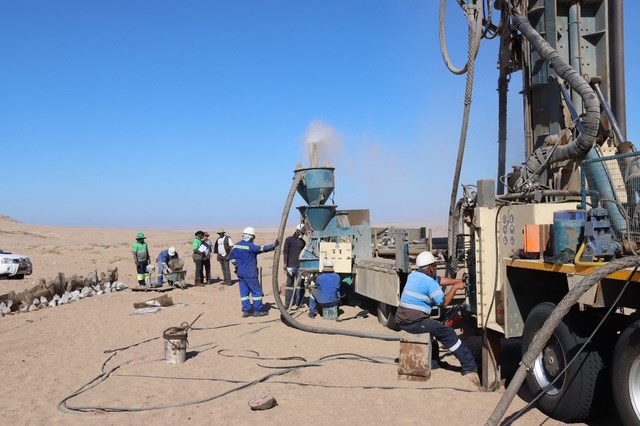
Assuming the Phase 2 drill program continues to go according to plan and assay results are received in a timely fashion, the preparation of a maiden mineral resource estimate for Engo Valley is targeted for completion before the end of 2025.
1 https://globaluranium.com.au
2 https://www.namibiansun.com/infrastructure/kaokoland-harbour-on-the-cards-again2023-11-29.


